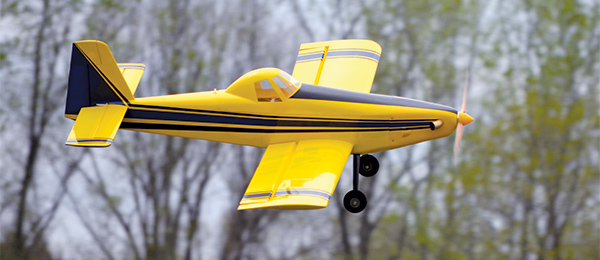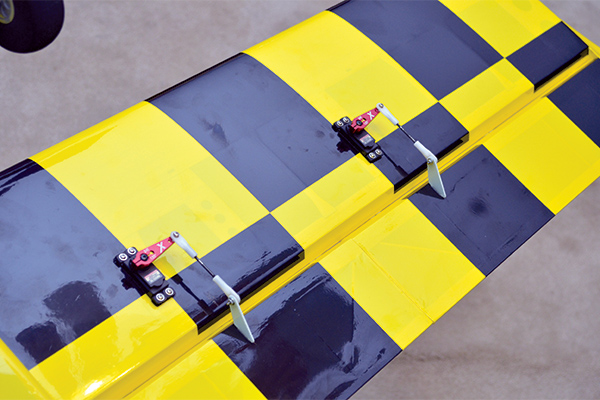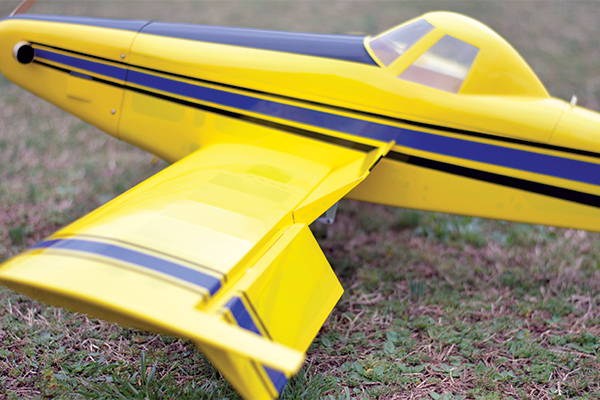Extreme Flight Legacy Aviation Turbo Duster

Written by Chris Mulcahy A fully capable sport scale fun flier Abridged product review Photos by the author Read the full product review in the July 2016 issue of Model Aviation.
Specifications
Model type: Sport scale ARF Skill level: Intermediate Wingspan: 65 inches Wing area: 747 square inches Length: 55 inches Weight: 5 pounds without battery Power system: Torque 4016T/500 MKII brushless motor; Airboss 80-amp ESC; 6S 3,000 to 4,000 mAh LiPo battery Radio: Minimum five-channel transmitter and receiver; six servos Street price: $349.95Test-model details
• Radio system: Futaba 14SG transmitter; Futaba R617FS receiver; six Hitec HS-7245MH servos; 6-, 12-, and 24-inch servo extensions; Extreme Flight aluminum 1.25-inch servo horns • Power system used: Torque 4016T/500 MKII brushless motor; Airboss 80-amp ESC; 6S 3,000, 3,300, and 5,000 mAh LiPo battery packs • Flying weight: 5.5 pounds without battery • Flight duration: 5 to 10 minutes, depending on battery sizePluses
• Stable, easy-to-fly aircraft. • High-quality build and hardware. • Lightweight. • Wide range of power options. • Floats available. • Hard points for floats already installed. MINUS • Wheels were extremely noisy; needed grease.Abridged product review
The Legacy Aviation side of Extreme Flight is the home of its general aviation sport airplanes. One of the company’s latest offerings is a 65-inch Turbo Duster, based on the real-life workhorse, the Air Tractor. The full-scale Air Tractor is used for a variety of crop-dusting and firefighting duties, and is built in Texas. The Turbo Duster that I am reviewing is a generic version of the Air Tractor that can be easily tailored to be a nice-looking scale model of any of the variants. As of this writing, a float set is in the process of being released. It will open a new aspect of flying the Turbo Duster, and will be perfect for modeling any of the firefighting versions out there. The power for the Turbo Duster comes from Extreme Flight’s recommended power system—in this case, a Torque 4016-500 motor coupled with an Airboss 80-amp ESC. The recommended propeller is a 16 x 7, and a Xoar 16 x 7 electric propeller was provided. I used the suggested Hitec HS-7245MH servos (six are required) with Extreme Flight 1.25-inch aluminum servo arms. Extreme Flight also carries spinners and servo extensions.
All of the accessories used in the review are available from Extreme Flight.

The recommended Torque motor and Airboss ESC are installed.
I used my Futaba 14SG transmitter with a Futaba R617FS receiver. The Turbo Duster features full-range flaps, which means that the flaps can travel all the way up, as well as down. This opens up a wide range of mixing possibilities. (You will need at least a seven-channel radio and receiver to have all of the control surfaces on their own channels.) I chose to set up three modes for my aircraft. The first was a conventional flap setting with the flaps assigned to a slider switch on my 14SG so that I could position the flaps in any lower position. The second setup was a mix that combined the flaps with the ailerons, essentially creating a full-span aileron on the wing. The third mix can be called crow, butterfly, and/or air brake. This mode deflects the flaps and ailerons opposite of each other to slow the airplane.
Flying
The flaps are fun to play with! With full flaps, the airplane will float along at a walking pace, and short field landings are a piece of cake. With a good headwind, I was able to land with what seemed to be roughly a 1-foot rollout. The ailerons have good authority by themselves, but when combined with the flaps, they give a stronger effect. It’s similar to switching to high-rate ailerons. It gives a crisp feeling when starting and stopping a rolling maneuver.
The ailerons and flaps are controlled with HS-7245MH servos. Aluminum 1.25-inch servo horns were also used.
The butterfly/crow/air brake feature worked great as well. In a complete nosedive, the air brake acts as a parachute and slows the airplane’s descent. I was able to start up high and nosedive vertically into a landing. On a conventional landing, if either the approach is too fast or you want to stop short as you are touching down, the air brake does a great job of slowing the airplane. I assigned the air brake function to a momentary switch so I wouldn’t inadvertently leave the air brake mix activated. This worked well for “tapping the brakes” on runway approaches.

Here you can see the deflection that’s possible with the flaps and ailerons.
The Duster is a perfect sport flier. It flies as easy as any trainer. If you want to take it to the extreme, the Turbo Duster can handle 3-D maneuvers. With its low-dihedral wing, however, it would not be my first choice for a 3-D-only flier. This airplane bridges the gap by giving you an awesome sport flier with scalelike looks, but if you want to rip up the sky with it, you absolutely can. Extreme Flight makes it easy to get the recommended gear you need to complete the model because its website is a one-stop shop. The Turbo Duster is big enough to present well in the sky, yet small enough to pack into most vehicles for transport. The airplane’s overall quality is outstanding—everything fit and was finished the way you would expect. I didn’t find any problems with the construction. I look forward to adding the floats. I think this model will make an excellent floatplane, and hard points for the floats are already built in. In the meantime, I’ll keep “dusting” cornfields and practicing ridiculously short takeoffs and landings! —Chris Mulcahy [email protected]










Add new comment